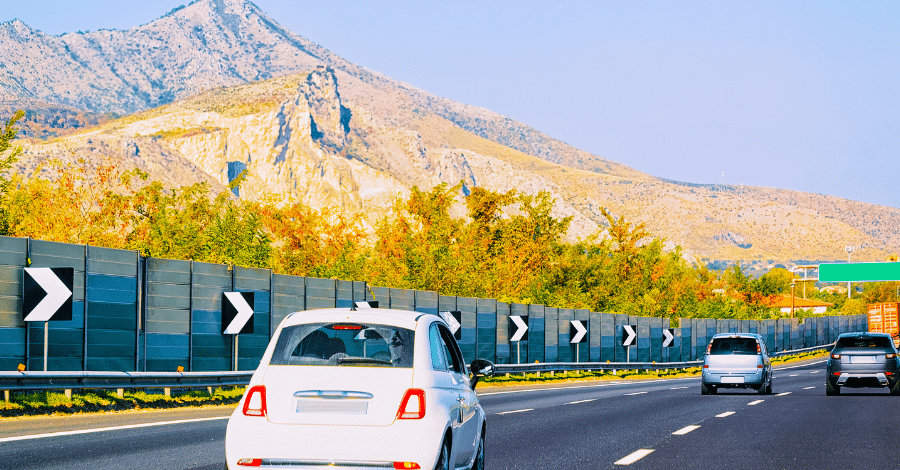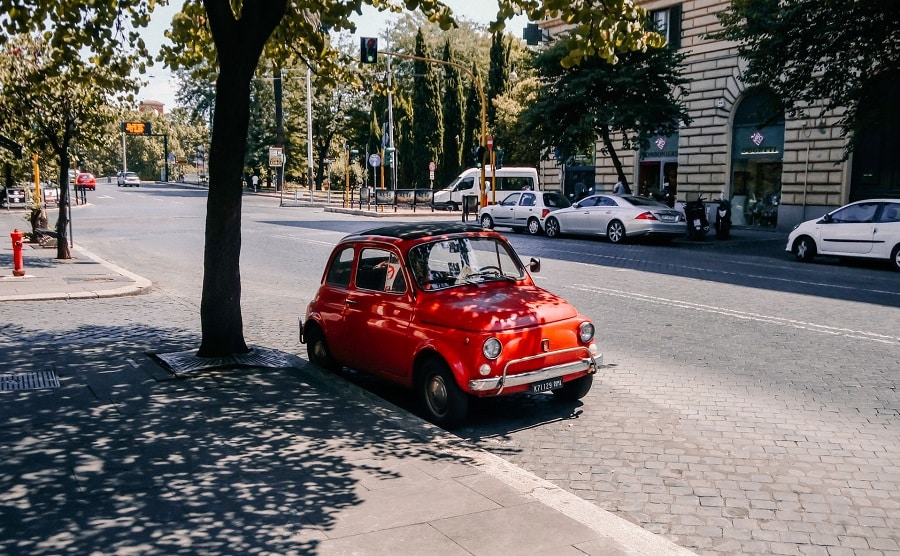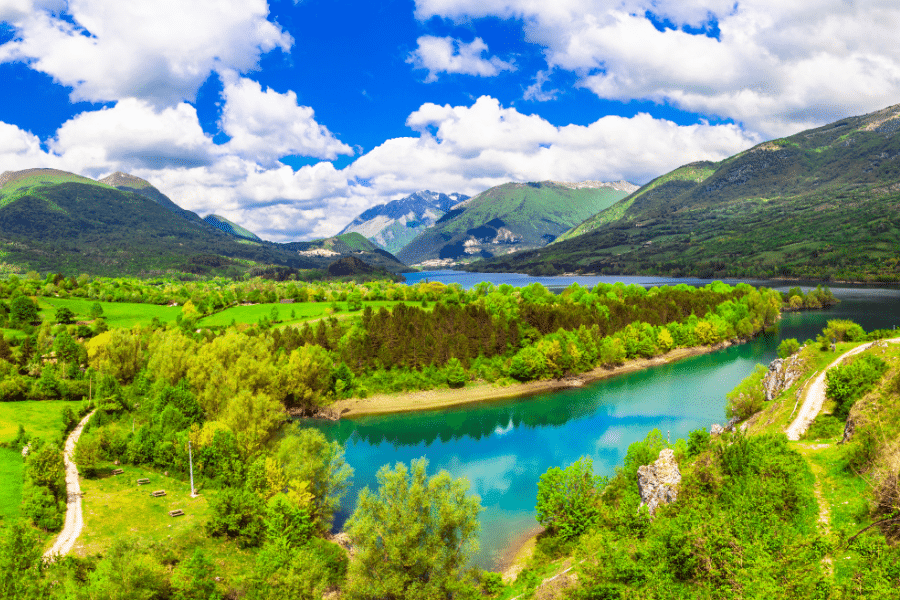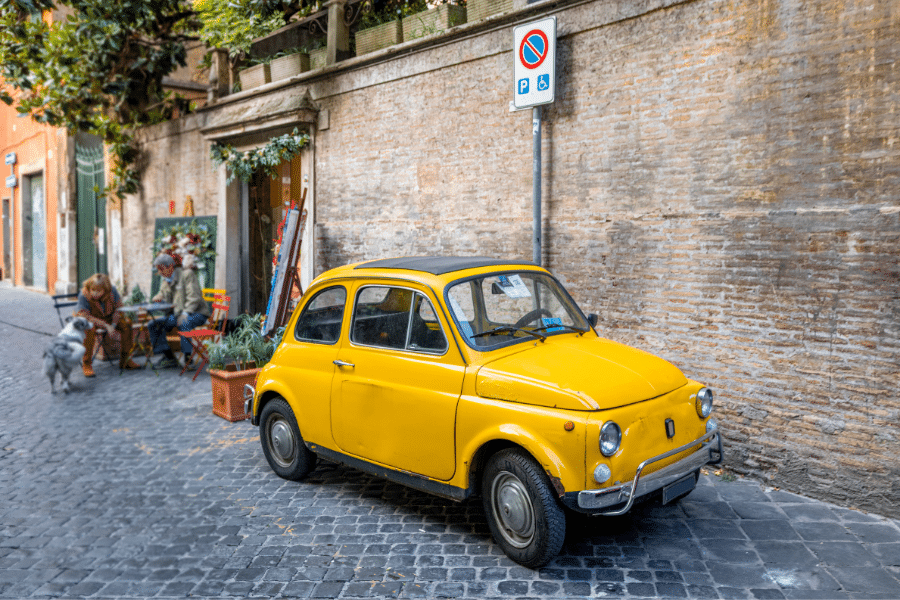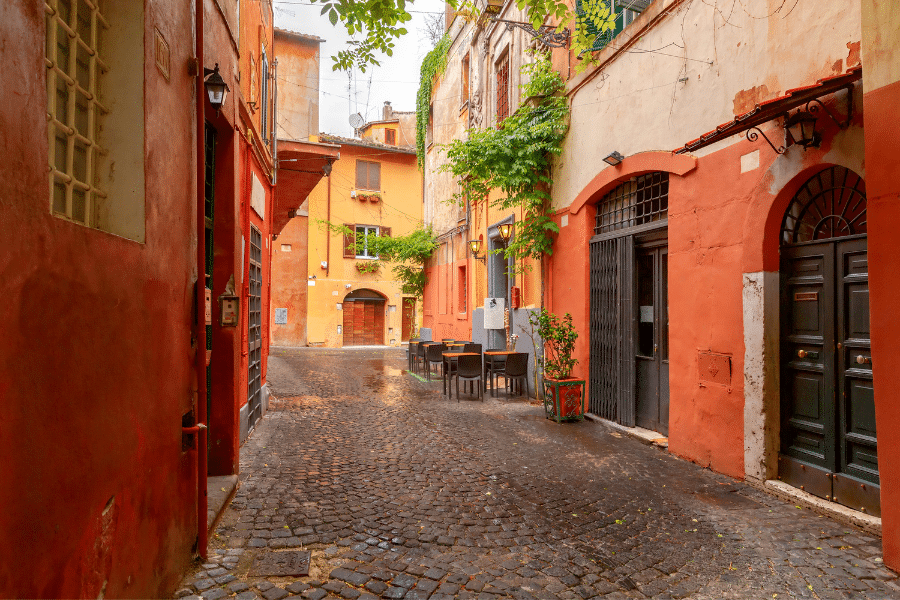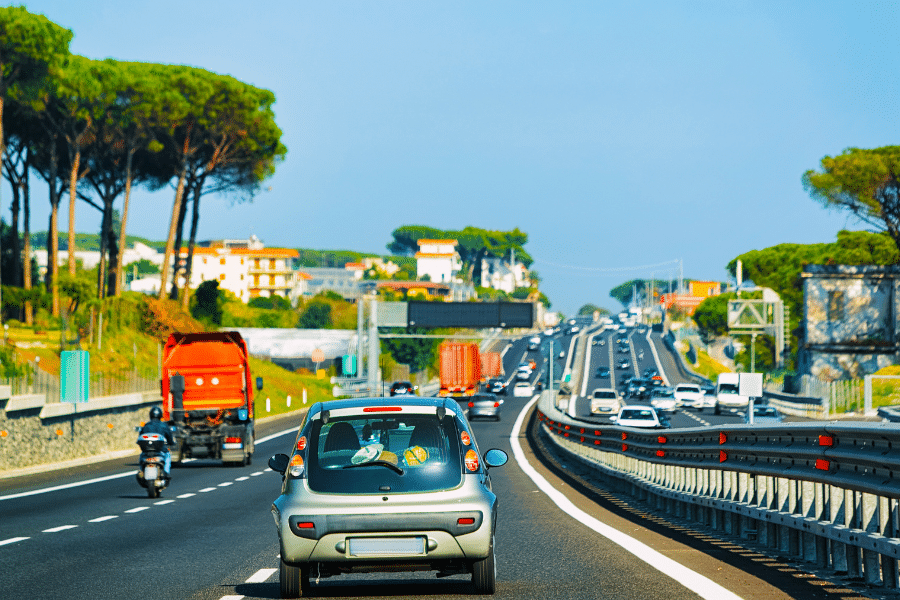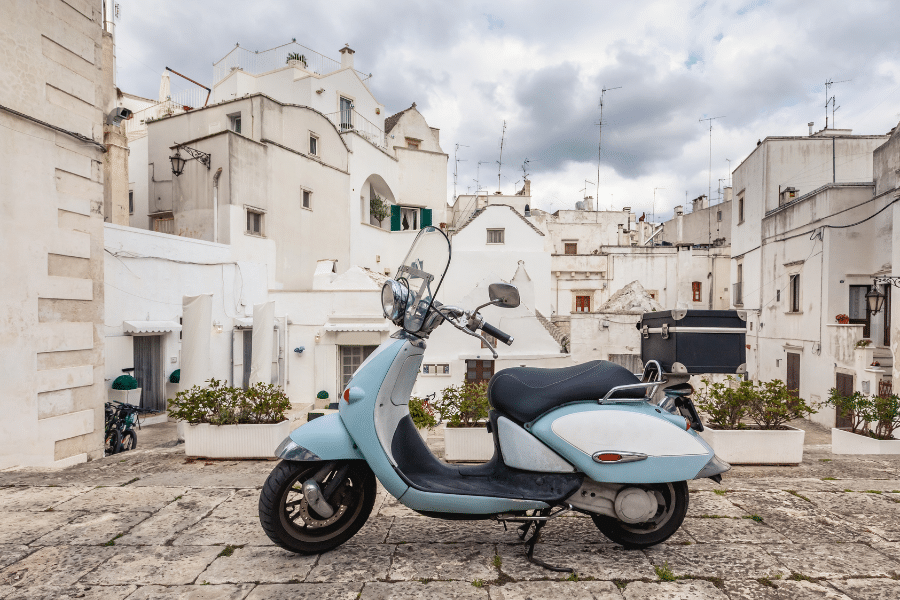Italy offers a range of transportation options for travelers, each catering to different needs and preferences.
The country has an extensive and efficient train network, with high-speed options like the Frecciarossa connecting major cities. However, trains are not available in all parts of the country, and schedules can be unreliable.
Buses provide a cost-effective means of intercity and regional travel, reaching destinations off the beaten path. Major cities have well-developed metro and tram systems for urban exploration. However, these means of public transportation are notoriously undependable and their official schedules are often inaccurate.
Renting a car in Italy offers maximum flexibility and comfort, ideal for rural and smaller-town exploration, long distances, big cities, and many scenic itineraries. The downside is that this option is more expensive than public transportation.
Taxis are convenient for city travel but tend to be pricier. Cyclists can enjoy scenic routes, and ferries and boats are essential for island hopping.
Domestic flights are an option for longer distances or island access, though they may not always be the most economical choice.
Advantages of traveling by car in Italy
Exploring Italy by car is the best way to enjoy this beautiful country as it offers the key ingredients of a successful trip:
1. Flexibility
Renting a car for traveling in Italy gives you the freedom to set your own itinerary and explore both popular tourist destinations and hidden gems at your own pace. You can easily deviate from the beaten path and make spontaneous stops along the way.
2. Access to remote areas
Italy’s scenic countryside and charming villages often require access by car. With your rental vehicle, you can reach remote areas, picturesque hilltop towns, and beautiful countryside that may not be easily accessible by public transportation.
3. Convenience
Car travel allows you to carry luggage and belongings with ease, eliminating the need to navigate public transportation with heavy bags. It’s also convenient for families or groups traveling together.
4. Scenic drives
Italy offers some of the most stunning scenic drives in Europe, from the Amalfi Coast’s dramatic cliffs to Tuscany’s rolling hills. With a car, you can take in these breathtaking vistas and enjoy the journey as much as the destinations.
5. Exploration at your own pace
You can linger in places that captivate you, whether it’s savoring a local meal at a countryside trattoria or spending extra time in a museum or historical site. You have the luxury of setting your own pace.
6. Off-the-beaten-path experiences
A car allows you to venture into lesser-known regions of Italy and authentic experiences that are often missed by tourists relying solely on public transportation.
7. Convenient day trips
With a car, you can easily embark on day trips to nearby towns and attractions without the constraints of unreliable train or bus schedules.
8. Privacy
You have the privacy of your own vehicle, allowing you to enjoy conversations and moments with your travel companions without the presence of other passengers.
9. Comfort
Car travel can be more comfortable, especially on longer journeys, as you have control over temperature, music, and stops along the way.
While exploring Italy by car has its advantages, it’s essential to be aware of local traffic rules, parking regulations, and road conditions to make the most of your journey. Additionally, consider the specific needs of your trip and whether a car aligns with your travel plans and preferences.
How to find a rental car for traveling in Italy
Most major rental car companies operate in Italy. However, their prices, inventory and policies can vary, so choosing which one to go with is not exactly straightforward.
Travelling abroad is filled with a lot of unknowns, but renting a car this day and age doesn’t have to be one, as there are websites that can make your car rental search as easy as can be.
The best and safest way to book a rental car when travelling internationally is by searching on a website like Discovercars.com, where you can compare offers, car availability and prices from all major rental car companies in one place.
In addition to filtering for location, price or type of car, you can also check ratings and reviews, or choose to look only at your preferred suppliers. A handy money-saving feature on discovercars.com is the ability to search for special offers and discounts. If you want to see only suppliers that have pickup locations in your airport terminal, you can do that on Discovercars.com.
The most important things to know when renting a car in Italy
1. Driving license
Ensure you have the necessary documentation for car rental, including a valid driver’s license.
An International Drivers Permit (IDP) is recommended for international travel as it serves as a handy supplement to your regular driver’s license. It provides essential information in multiple languages, including a photograph.
While a valid U.S., Canadian, or UK driver’s license can typically be used in Italy for stays under six months, having an IDP adds an extra layer of convenience and peace of mind.
2. Age and other limitations
The official driving age in Italy is 18. Most rental companies in Italy will require you to be at least 21 years old to rent a car.
Additionally, many companies may demand that you have held a valid driver’s license in your home country for a year or more.
Be aware that there might be extra charges if you are under 25 or over a certain age. It’s essential to carefully review the rental terms and conditions.
To avoid surprises, you can use platforms like Discovercars.com to input your age and explore any potential limitations or additional fees associated with renting a car in Italy.
3. Forms of payment
When renting a car in Italy, rental companies will typically ask for your credit card to hold a deposit, separate from the rental payment, known as the “excess charge.”
This amount is temporarily blocked on your credit card and can impact your available credit.
To prevent any issues, consider using a credit card with a sufficient limit or contacting your bank before your trip to adjust your credit limits accordingly.
Alternatively, you can opt to purchase a full coverage insurance package with a zero excess charge directly from the rental company, which eliminates the need for a deposit and provides peace of mind during your Italian road trip.
Tips to ensure a positive experience when renting a car in Italy
1. Type and size of rental car
Renting a car in Italy can be a fantastic way to explore the picturesque villages and countryside, but there are a few essential considerations to ensure a smooth experience.
First, when selecting a car, it’s wise to avoid opting for one that is too wide, especially if you plan to visit smaller villages. Many Italian villages have narrow, winding streets, and a compact vehicle will navigate these charming roads with greater ease.
Booking your rental car early is another crucial tip to remember. By doing so, you not only increase your chances of securing the best prices but also have a wider range of car choices at your disposal. Italy’s popularity as a tourist destination means that rental cars can be in high demand, so reserving ahead of time allows you to pick the vehicle that suits your needs and preferences.
A lot of people have their hearts set on the famous Fiat 500 model and want to rent it when in Italy. Because of the very high demand, this model is often unavailable, even when reserved in advance. Rental car companies cannot usually guarantee you will receive the exact make and model you booked. Keep an open mind that it is very likely you may get a similar car rather than a Fiat 500.
2. Preventing vehicle damage
Upon your arrival to pick up the rental car, always take a moment to thoroughly inspect the vehicle. Be meticulous, and don’t forget to check even the less obvious spots like the roof and under the bumper.
To safeguard yourself from potential disputes over damages, consider taking pictures of any pre-existing issues. This practice ensures clarity and transparency, minimizing the risk of unexpected charges when you return the car.
When it comes to avoiding potential scams, be vigilant about documenting any damages to the rental car upon pickup. Some rental companies may attempt to charge you for damages that were not your fault. Taking your own pictures and ensuring that any pre-existing damages are documented in writing can serve as your safeguard against such situations, allowing you to enjoy your Italian adventure with peace of mind.
While driving in Italy can be a rewarding experience, it’s essential to plan your route carefully, particularly in places like Rome, Florence or the Amalfi Coast, where navigating narrow, winding streets can be challenging.
3. Driving inside cities
Public transportation, such as trains, trams, and buses, often offers a more convenient and stress-free way to explore urban areas. Moreover, many Italian cities, like Rome, Bologna, or Lecce, have highly restricted traffic in their historic centers or inside the city walls, where you can only enter with special permits and the fines for breaking these rules are steep.
Be sure to check the local rules for driving inside your destination city’s center. This information is typically available online, or you may check with your local host. You will be able to find paid secure parking outside the city walls to park your rental car.
Save your car rental for adventures in the countryside, where the open roads and scenic landscapes truly shine.
4. Choosing manual or automatic
Many Italian cars come equipped with manual transmission, and if you prefer an automatic, you may have fewer options available at a higher cost. To ensure a seamless driving experience, make sure you’re comfortable with the transmission type you choose.
If you haven’t driven a manual car in years or ever, your best bet is to stick to what you know, so you can fully enjoy your trip. You can always reserve a rental car with automatic transmission, and most rental car places have plenty of choices on their fleet at the ready.
5. What types of fuel are common in Italy?
These are the most common fuel options for rental cars in Italy:
- Unleaded gas is referred to as “gasolina sem chumbo.”
- Diesel fuel is known as “gasoleo.”
- If you’re considering LPG, it’s called “GPL.”
- Electricity
Electric vehicles are becoming more popular in Europe, including Italy. While Italy is developing its network of charging points, it’s essential to check the concentration of electric car charging stations in your destination beforehand. You can find useful information on websites dedicated to this purpose.
6. Do I need a four-wheel drive rental car in Italy?
In most of Italy, having a 4WD (Four-Wheel Drive) vehicle is generally not necessary for most travel situations. If you are driving on mountain roads in the winter, then a four-wheel drive is certainly a smart choice.
It’s important to note that even if you opt for a 4WD rental, the insurance protection typically does not cover off-pavement use. This is a common restriction in many countries, so it’s advisable to carefully read the rental agreement’s fine print to understand the limitations and ensure you’re driving within the covered parameters.
Renting a car in Italy can enhance your travel experience, providing the freedom to explore at your own pace. Understanding fuel options, checking electric vehicle charging infrastructure, and being aware of 4WD limitations are key aspects to consider when planning your Italian road adventure.
7. Roads and highways in Italy
Italy boasts an extensive network of roads and highways, making it a convenient country to explore by car. Highways are the fastest way to get around Italy, but they’re not free. They are generally toll-roads and the cost of using them can vary depending on the distance traveled and the specific route taken.
On average, you can expect to pay around 5-10 euros for a short journey and up to 50 euros or more for longer trips. Keep in mind that some of the more scenic routes, such as those through mountain passes, can have higher tolls. Payment methods typically include cash, credit/debit cards, or electronic toll collection systems like Telepass.
To navigate the toll roads of Italy efficiently, it’s a good idea to have some cash on hand, especially for shorter trips. Credit and debit cards are widely accepted, but it’s advisable to check with your card provider about any foreign transaction fees.
If you plan to travel extensively in Italy, you might consider getting an electronic toll collection device like Telepass, which can save you time and provide convenience at toll booths. Additionally, be aware that toll booths can get busy, particularly during peak travel times, so factor in potential delays when planning your journey.
Overall, Italy’s toll roads are well-maintained and offer excellent connectivity, making them a great choice for exploring the country’s diverse landscapes and charming towns.
8. Watch out for scooters
Scooters are extremely popular in Italy and very prevalent on roads everywhere, both inside cities and on intercity connecting roads. As you are driving your car throughout Italy, be prepared to see Vespas and similar scooters zooming past you, in front of you or behind you frequently, no matter how narrow the road or how congested the traffic.
Scooters can be unnerving for drivers who are not familiar with driving in Italy and rather dangerous. However, being alert, driving safely, avoiding any sudden turns or impulsive moves is a good way to share the Italian roads safely with your fellow scooter drivers.

